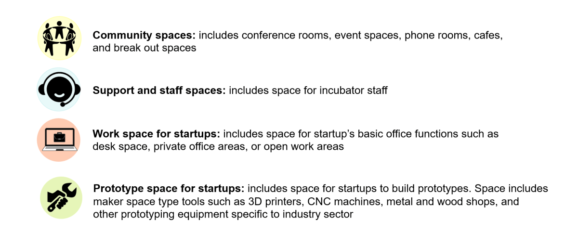Space for Innovation & Creation

Recently I had the great opportunity to participate in Design Museum Boston’s “Design Museum Mornings”. The topic of my discussion was “Spaces for Innovation”, highlighting our recent projects for a variety of incubator spaces. In the last few years, STA has developed a specialization in incubator spaces, but no two spaces are alike – there is no formula, no set of strict rules, but there are common threads that weave between them.
We’ve designed, and continue to design for incubator spaces in clean tech, robotics, medical innovation, music and entrepreneurship for veterans. Greentown Labs is the largest cleantech incubator in the US; MassRobotics is an incubator space for the robotics sector in Boston’s Seaport, The Record Co (TRC) is a non-profit offering rehearsal and recording space to Boston-area musicians; Flextronics’ Flex Innovation Center is a design and production facility that supports startups and large multinational customers; Miraki Innovation is a venture capital firm in Harvard Square that is inviting their entrepreneurs to share their office and maker space, and Massachusetts Fallen Heroes Innovets center is a space to support entrepreneurship for veterans and Gold Star families.

Here are some key points about the design of incubators:
There is no “one-size-fits-all” approach
There is no one-size-fits-all solution for incubator spaces, as each market sector has its own unique requirements. The designer has to fully understand their mission, values and goals, their business models, and their unique programmatic needs and resources.
Miraki’s mission is “to create revolutionary ideas into revolutionary companies”; TRC’s mission is “to remove the technical barriers between Boston’s music makers and their creative visions through truly affordable music workspace and professional development programs”, Greentown’s mission is “to enable a vibrant community of startups to realize their visions by providing access to the resources, labs, and funding they need to thrive”. The common thread is about creating community and providing resources that will make great things happen.

But the program needs and business models vary greatly. Some incubator models are based on membership, but the membership models vary – in some they rent by the desk, or the chair; some rent per office space. Understanding this model is key to how the space is designed, even down to the detail of what furniture is specified. Will there be open desking? Private offices? Shared offices? How are common spaces allocated? These are the details that need to be outlined carefully during the programming phase to ensure that the model is viable.
In addition to workspace, the market specific support spaces are key. Greentown has prototyping and wet lab space; MassRobotics has a machine shop and electronics labs; TRC has music studios and rehearsal spaces. A common program element is community / event space, but they take different forms based on the specific needs and goals of the group.




Bring the community to the table
How do you design for an incubator community? You bring them to the table in an inclusive way. At Greentown Labs‘, their spirit of community and inclusivity was paramount throughout the design process. Every design meeting was open to every member of every company, and some ground-breaking ideas came of these meetings. At Miraki, every member of the venture team as well as the companies in which they were investing were invited to the design process. At TRC, musicians, producers and staff are all part of the process, with outreach happening not only at the studio, but at concerts and shows. Hearing the feedback from the people who will use the space first hand is priceless.


Brand and Identity
One of the challenges of the incubator culture is defining a brand, a look and feel for the space that represents the culture of the organization, while allowing the individual companies to have their own identity. We work to design a space that represents the culture of the organization – when you are at Greentown you know it is a Greentown space, when you are at MassRobotics you know you are at a MassRobotics space, but the design of the spaces makes room for the individual companies to express themselves. The culture of these spaces is innovation, and the space is designed to allow for innovation to happen, but without being prescribed — maintaining each organization’s “vibe” was important to maintain. There is a visual system in the space, but no strict rules. There’s flexibility for companies to grow and create their own identity. The company brand identities are not necessarily consistent with the overall brand, and that’s OK!



Flexibility and Adaptability
Since the nature of incubators is somewhat transient, the space needs to be adaptable to change. Most incubators are designed to “grow” and “graduate” companies, so allowing for the flexibility of space needs to be considered from the outset, in every way from the planning through the furniture.


The design of incubator spaces requires the designer to be as open-minded and forward-thinking as the entrepreneurs and community members who will grow in the space. It is truly exciting to be a part of the growth of these innovative communities!
For more information on Greentown Labs, here’s an article written about the project in the Winter issue of Design Museum Magazine.


-David
